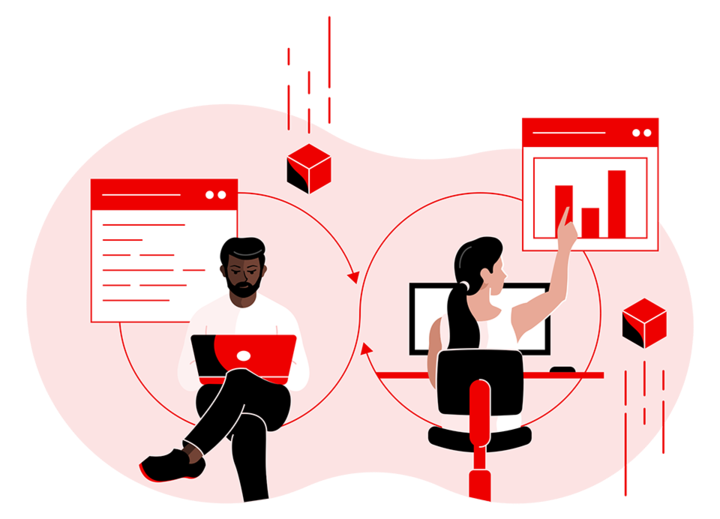As software delivery becomes more complex and organizations work to scale their DevOps transformations, the need for observability increases. While observability plays an important role in any DevOps journey, it is often confused with monitoring. Although both are typically discussed in the same context, they are not one and the same.
To help establish a clear picture, I asked SKILup Day participants and DevOps Institute ambassadors to clarify some of the key differences. Here’s what they said:
Collection vs. context
"Monitoring is the collection of metrics, traces, and logs from sampling or spot-checking systems in your environment. The result is large amounts of data, which users can explore and extract to gain insights."
“Observability ditches sampling for capturing every trace from everywhere, at high granularity, including containerized microservices. Observability also makes the data available in context, with ancillary information, so you can take meaningful action without having to go into the monitoring data stores.” Priya Satheesh, CEO Instana
[ What DevSecOps tools might your team consider? Read also: 5 DevSecOps open source projects to know. ]
Characteristic vs. act of observing
“Observability is a characteristic of systems – that they can be observed. It requires intentional behavior during digital product and platform design and a conducive architecture. Observability is not monitoring. We monitor when we observe our observable systems and the tools category that largely makes this possible.” -Helen Beal, chief ambassador, DevOps Institute
Process vs. potential
"Monitoring is the process of using observability. When monitoring occurs, one has already decided which events and applications will be tracked. Observability creates the potential to monitor different events along the pipeline and the overall software development lifecycle. As processes get built, the potential for observability should be included across a broad spectrum. Monitoring finds specific events across the system and creates artifacts and reports that can be integrated into overall metrics." -Mark Peters, technical lead, Novetta
Single plane vs. traversable map
“Monitoring is a single plane for the most part. You set up rules, aggregations, and alerts on when a known scenario plays out (e.g., a trajectory towards 100% disk usage is an indication of an issue in the imminent future). Observability, on the other hand, is the means to map an environment or context and the ability to fluidly traverse that map, thus reaching a greater awareness of ‘what is.’” -Ryan Sheldrake, field CTO, Lacework
Key criteria vs. complete assessment
"Observability is a key design and development criteria for application development wherein data is made available from within the system that should be monitored. Observability is achieved by assimilating information from logs and monitoring tools and representing this information in a way that gives actionable insights into the whole application setup and its environment."
"On the other hand, monitoring is observing the state of an environment over a period of time and is mostly about the display of information to the SRE team."
“The key difference between observability and monitoring is that compared to monitoring, site observability gives a more complete assessment of the overall environment in which the application resides and hence is more effective in fulfilling the key success factor for an application – that of site reliability.” -Sushant Mehta, senior manager application development, Diyar United Company
Understanding vs. action
"Monitoring is about putting mechanisms in place that allow teams to watch and understand the state of their systems. It is based on gathering predefined sets of metrics or logs. The main purpose of monitoring is to control a system’s health by actively collecting error logs and system metrics and then leveraging those to alert about incidents."
“Observability is about putting mechanisms in place that allow teams to actively debug their system. It is based on exploring properties and patterns not defined in advance. The main purpose of observability is to use the system’s outputs to gather insights and act on them.” -Parveen Arora, co-founder and director, VVnT SeQuor
Tracking vs. knowledge
"In general, when you’re monitoring anything, you need to know exactly what data you’re looking at. If/when something goes wrong, a good monitoring tool will notify you of what is going on depending on what you are monitoring. Monitoring is used to track performance, discover faults and abnormalities, determine the root cause of problems, and get insights into physical and cloud settings."
"Observability examines system outputs and assesses how well you comprehend a system’s internal states. It is the result of control theory. Instrumentation is used by observability to give insights that help in monitoring. Monitoring, in particular, is what you do once a system is visible. Monitoring is impossible without some amount of observability."
[ Could DevOps bolster your digital transformation? Read Digital transformation: 10 more ways DevOps can help. ]
“Consider observability to be the knowledge you need to know exactly what to monitor. Observability is more than simply a fancy word for monitoring. It is proactive, employing logs, machine learning, and causality to construct a comprehensive system that is visible to everybody.” -Supratip Banerjee, solutions architect, Principal Global Services
Wide vs. deep
"Monitoring has been a well-known framework and concept used over the years to provide a wide view of system behavior and performance, allowing you to analyze trends, dashboards, and alerts."
"The main difference is that observability compliments monitoring, using different telemetry sources to provide the deep state of all system components."
“Ben Sigelman said, ‘Do not mistake the coexistence of metrics, tracing/ APM and logging for observability.’” -Jose Adan Ortiz, solutions engineer, Akamai Technologies
[ To continue advancing your observability knowledge, join DevOps Institute for SKILup Day: Observability on September 23. ]
Limited vs. sustainable
“Observability is a sustainable approach above monitoring operational insights, better incident management, and quality control, contributing to a better product. It helps you secure actionable insights for better decision-making and a faster feedback loop. When I talk about observability, I love to talk about the quote, ‘If you are observable, I can monitor you,’ and that pretty much sums it up.” -Anshul Lalit, head of technology and transformation, Kongsberg Digital
[ How do containers and Kubernetes help manage risk? Read also: A layered approach to container and Kubernetes security. ]






